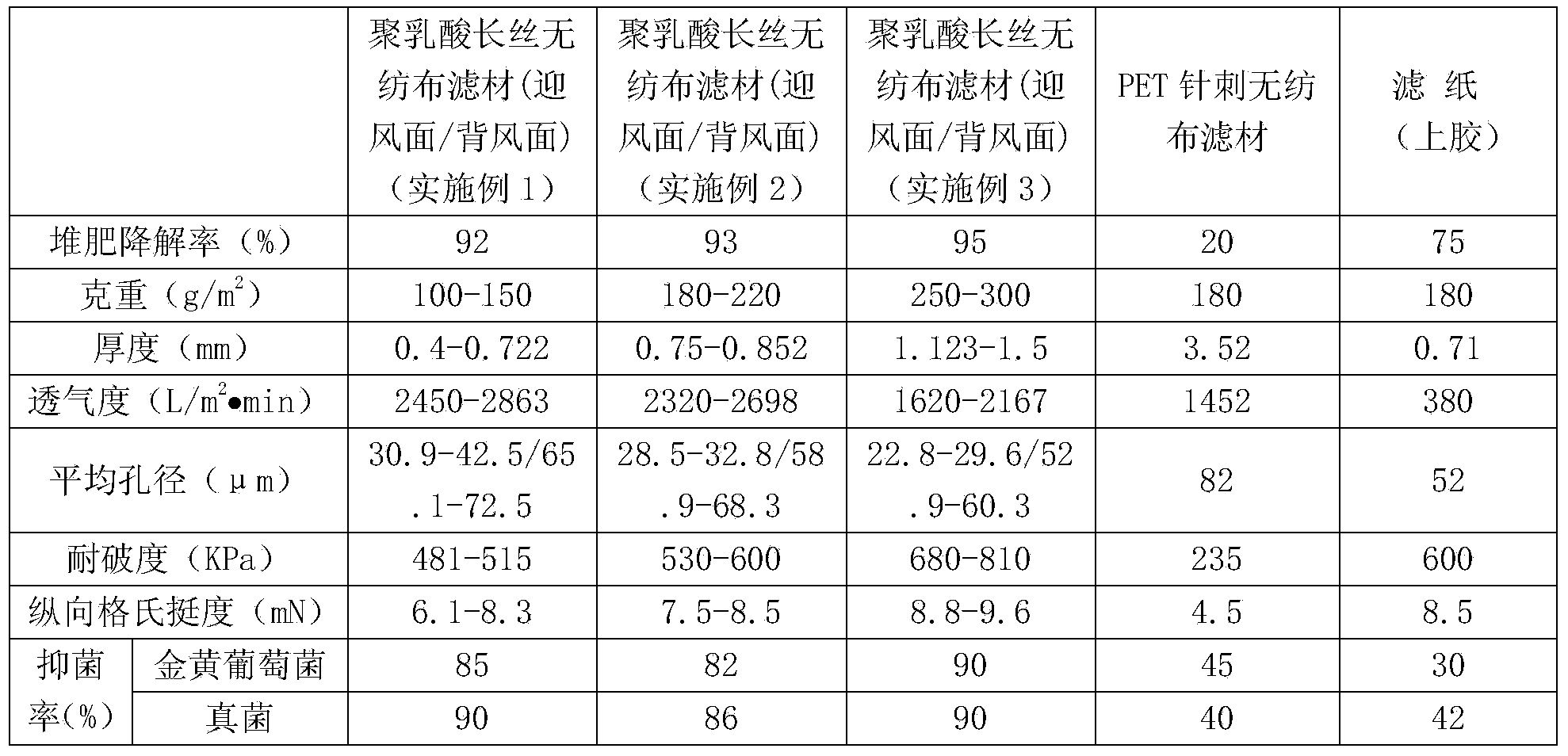Polylactic acid filament yarn non-woven filter material and application thereof
A technology of filament non-woven fabrics and filter materials, which is used in filtration separation, dispersed particle filtration, and dispersed particle separation, etc., can solve the problems of reduced filter life, large environmental pollution, and increased pressure difference, and can achieve replacement and installation time. Short, filter area increase, reduce the effect of cleaning times
- Summary
- Abstract
- Description
- Claims
- Application Information
AI Technical Summary
Problems solved by technology
Method used
Image
Examples
Embodiment 1
[0029] After the pre-crystallized polylactic acid slices are fully dried, they are melted and extruded by the first spinning unit, spun, cooled and drawn, and divided into wires, and at the same time, the pre-crystallized and fully dried polylactic acid slices are Through the melt extrusion of the second spinning unit, spinning, cooling and drawing, splitting and laying on the fiber web formed by the first spinning unit, the upper and lower layers of fiber web are superimposed to form a composite fiber web, and then through It is hot-pressed and wound into a polylactic acid filament non-woven fabric roll.
[0030] The polylactic acid chips used are polylactic acid-polybutylene succinate blends. During the spinning process, the spinning temperature of the first spinning unit is 210-215 ° C, negative pressure drafting, and the drafting wind pressure is 0.45- 0.5MPa, the air drafting speed is 3800-4000m / min, the linear density of the polylactic acid filament fiber in the web is 3...
Embodiment 2
[0033] After the pre-crystallized polylactic acid slices are fully dried, they are melted and extruded by the first spinning unit, spun, cooled and drawn, and divided into wires, and at the same time, the pre-crystallized and fully dried polylactic acid slices are Through the melt extrusion of the second spinning unit, spinning, cooling and drawing, splitting and laying on the fiber web formed by the first spinning unit, the upper and lower layers of fiber web are superimposed to form a composite fiber web, and then through It is hot-pressed and wound into a polylactic acid filament non-woven fabric roll.
[0034] The polylactic acid chips used are polylactic acid-polypropylene glycol block copolymers. During the spinning process, the spinning temperature of the first spinning unit is 215-220°C, negative pressure drafting, drafting wind pressure is 0.35-0.45MPa, and the airflow The drawing speed is 3500-3800m / min, the linear density of the polylactic acid filament fiber in the...
Embodiment 3
[0037] After the pre-crystallized polylactic acid slices are fully dried, they are melted and extruded by the first spinning unit, spun, cooled and drawn, and divided into wires, and at the same time, the pre-crystallized and fully dried polylactic acid slices are Through the melt extrusion of the second spinning unit, spinning, cooling and drawing, splitting and laying on the fiber web formed by the first spinning unit, the upper and lower layers of fiber web are superimposed to form a composite fiber web, and then through It is hot-pressed and wound into a polylactic acid filament non-woven fabric roll.
[0038] The polylactic acid slices used are homopolymers of lactic acid monomers. During the spinning process, the spinning temperature of the first spinning unit is 220-230°C, negative pressure drafting, drafting wind pressure 0.5-0.7MPa, air drafting speed 2500-3000m / min, the linear density of the polylactic acid filament fiber in the fiber net is 7-8dtex, and the cross-se...
PUM
| Property | Measurement | Unit |
|---|---|---|
| pore size | aaaaa | aaaaa |
| pore size | aaaaa | aaaaa |
| thickness | aaaaa | aaaaa |
Abstract
Description
Claims
Application Information
 Login to View More
Login to View More - R&D
- Intellectual Property
- Life Sciences
- Materials
- Tech Scout
- Unparalleled Data Quality
- Higher Quality Content
- 60% Fewer Hallucinations
Browse by: Latest US Patents, China's latest patents, Technical Efficacy Thesaurus, Application Domain, Technology Topic, Popular Technical Reports.
© 2025 PatSnap. All rights reserved.Legal|Privacy policy|Modern Slavery Act Transparency Statement|Sitemap|About US| Contact US: help@patsnap.com


